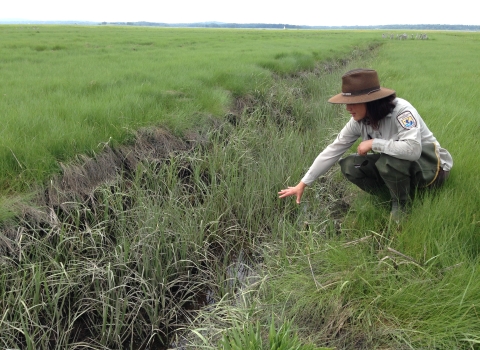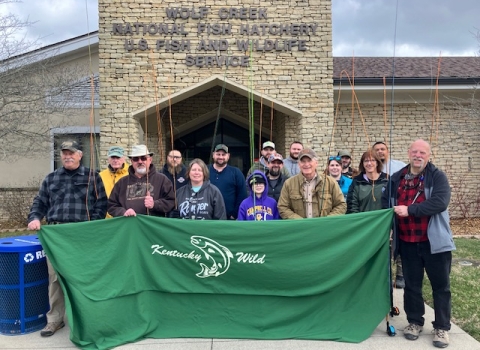Climate change, habitat loss, invasive species invasive species
An invasive species is any plant or animal that has spread or been introduced into a new area where they are, or could, cause harm to the environment, economy, or human, animal, or plant health. Their unwelcome presence can destroy ecosystems and cost millions of dollars.
Learn more about invasive species – the list of threats to the fish, wildlife, and plants that make our landscapes home is long and growing. While there are many dedicated people working to tackle these challenges today, the future health of the wildlife and habitats that sustain us relies on the next generation of conservationists.
Nestled within the northern Rocky Mountains is the University of Montana, a school known for its wildlife biology and resource management programs. There, students learn from leaders in the field of natural resources to develop into the conservationists of tomorrow. Students come to the university from diverse backgrounds, each bringing the values and perspectives of their communities to the world of conservation. While many students enter the university’s conservation programs with a love for nature, one demographic of students enters with connection to the land since time immemorial – Native American students.
In many Native American families, elders tell children detailed stories about the history of their lands and wildlife. Having grown up with these stories, native students come to the university with unique knowledge about wildlife management and conservation.
We had the pleasure of hearing about the journeys of three native students, Sattie Whitefoot-Fisher, Ken Edmo, and Xavier Lovato, who are in the first cohort of a new program at the University of Montana funded by the U.S. Fish and Wildlife Service’s Science Applications Program and Sloan Indigenous Graduate Fellowship Program and designed to better support Native American graduate students.
LISTEN to the students share their stories on YouTube here
Download the full audio story transcription text here
Xavier Lovato
Xavier Lovato is from Cochiti and Kewa Pueblos along the Rio Grande River in New Mexico. His interest in wildlife comes from his grandparents and his culture’s connections to nature. Lovato grew up with his grandparents telling stories and illustrating how pottery designs tie back to the songs and ceremonies of their culture and the landscape that supports them.
As a young volunteer, Lovato worked with the U.S. Fish and Wildlife Service on a fish passage fish passage
Fish passage is the ability of fish or other aquatic species to move freely throughout their life to find food, reproduce, and complete their natural migration cycles. Millions of barriers to fish passage across the country are fragmenting habitat and leading to species declines. The U.S. Fish and Wildlife Service's National Fish Passage Program is working to reconnect watersheds to benefit both wildlife and people.
Learn more about fish passage and restoration projects for Rio Grande suckers. Lovato received his undergraduate degree in wildlife science at New Mexico State University. He started graduate school in the Wildlife Biology program at University of Montana in 2021 where he now studies the potential of using acoustic monitoring to assess Mexican spotted owl occupancy and habitat use on the Mescalero Apache reservation. Results from his project will help inform spotted owl conservation and forest management.
After he graduates, Lovato would like to work for a state or federal wildlife agency. He hopes to someday return to his community as a wildlife biologist to share his knowledge.
Ken Edmo
Ken Edmo has spent most of his life on the Flathead Indian reservation in Northwest Montana. Home to the Confederate Salish and Kootenai Tribes, the reservation is a stunning landscape: a wide valley interspersed with forests, lakes, rivers, wetlands, and rural communities, that is rimmed to the east by the Mission Mountains.
As a young child, Edmo’s interest in conservation was inspired by Jane Goodall’s research on primates.
“I remember seeing Jane Goodall on the TV and thinking that what she was able to do with primates was so incredibly interesting. It gave me the drive to pursue a job in conservation. I wanted to be like her when I grew up,” Edmo said.
He obtained his undergraduate degree in the Wildlife and Fisheries program from Salish Kootenai College. In 2020, Edmo started at the University of Montana and is pursuing a master’s degree in resource conservation.
Edmo’s project aims to determine how conflicts between people and grizzly bears can be reduced by effectively managing food attractants. He will examine agency and tribal regulations, recommendations, and resources on food storage, and synthesize this information into products that are easily understood and accessible by the public.
After Edmo graduates with his master’s degree, he plans to pursue work in wildlife conservation focusing on large terrestrial mammals.
Sattie Whitefoot-Fisher
Sattie Whitefoot-Fisher grew up on the Yakama Nation reservation in central Washington with her family. As a kid, she spent her days connecting with the land through hunting, fishing, and hiking in the Cascade Mountains. Whitefoot-Fisher earned her undergraduate degree from Salish Kootenai College before being accepted into the Wildlife Biology Master’s program at University of Montana in 2020.
Her master’s project focuses on identifying the impacts of feral horses on deer and elk populations in Washington. In addition to collecting data through deploying camera traps in the field, Whitefoot-Fisher will survey Yakama Nation elders and community members about the history of wild horses on the landscape to incorporate traditional ecological knowledge into her results. The information gathered during her project will help inform feral horse management decisions on the reservation.
After graduating with her master’s in spring 2023, Whitefoot-Fisher hopes to work for a Tribal organization. As part of her future career, she wants to help raise and find funding that supports native youth travel opportunities, internships, and schooling.
“If it wasn’t for all the funding I received throughout the years, I would not have gotten to do any of the things I got to do – internships, travel, or even finishing school. I want to work on outreach programs to help younger generations find resources that will allow them to have the same opportunities I have had.”
Mentors and hands-on experience
Though each student navigated their own path to graduate school, several aspects of their journeys ring true for all – the importance of dedicated mentors and hands-on experience.
Each student had a mentor who helped guide them from their undergraduate programs into their graduate programs, offering encouragement and advice along the way. For example, Whitefoot-Fisher didn’t think she would be able to go to graduate school. However, her mentor made sure she knew it was an option if she wanted it.
“When I told my mentor I wasn’t sure if I was smart enough or if I would be able to get funding for graduate school, she told me: ‘First of all, you are smart enough. Second of all, we’re going to find you funding. Third of all, you’re an awesome Native American woman who’s in science. There’s no way we can’t figure this out for you. Give me your next excuse. I’ll cross that off the list too! We’re getting you to grad school.’ ” Whitefoot-Fisher said.
Edmo and Lovato echoed Whitefoot-Fisher’s deep appreciation for the role of their mentors.
The students also spoke to how important hands-on experiences were in getting them to where they are today. When Lovato was an undergraduate, he had the opportunity to work as part of a collaboration between his university and the Cochiti Pueblo where students helped tribal members build greenhouses also known as hoop houses for agriculture. Once the hoop houses were built, the university was allowed to take students there for outreach events. This made a big impact on Lovato.
“It was really cool to do that because before that, I didn’t know universities could even partner with tribes. I think it should happen a lot more.” Lovato said.
But while the students were grateful for the mentorship and experiences that helped put them on the path to graduate school, they called for more support for youth in native communities.
“A lot of native youth are discouraged, especially high school students. They don’t think they can go to college or travel. Most don’t have their own cars and most haven’t flown on an airplane before. Universities and agencies need to do more outreach that targets up and coming students and provides more opportunities for travel and hands on learning. That will drive students to apply and be more open to their education.” Lovato said.
The students suggested having representatives from universities and agencies travel to tribal colleges to give presentations and speak to students. They proposed creating and sharing resources within native communities that compile travel, internship, and funding opportunities. They also called for more outreach and assistance in navigating the graduate school admission process.
While universities still have a long way to go in supporting native students, the University of Montana has made big strides in the right direction. Whitefoot-Fisher, Edmo, and Lovato’s program was created to better support native students who are interested in graduate school by removing barriers such as funding. Traditional funding sources often require students to work on projects that include predetermined objectives, deliverables and timelines that do not leave much room for student preference. As native students often have very strong ties to their communities and want to work on projects that provide direct community benefits, it can be hard to find flexible funding that supports their needs. In partnership with the U.S. Fish and Wildlife Service’s Science Applications Program and the Sloan Indigenous Graduate Fellowship Program, the University of Montana is able to provide funding to native students regardless of their projects, thus supporting both their educational and cultural needs. The school also provides support through their Native American Natural Resources Program Manager, Jennifer Harrington, who helps answer questions, offers direction, and works to build an inclusive community throughout student’s natural resource degree programs.
Sattie Whitefoot-Fisher, Ken Edmo and Xavier Lovato are leading the way for younger generations in their communities to continue their education. The University of Montana, U.S. Fish and Wildlife Service’s Science Applications Program, and Sloan Indigenous Graduate Fellowship Program are proud to support them as they grow into conservation professionals.
A special thank you to the students’ dedicated mentors Serra Hoagland, Janene Lichtenberg, Alex Metcalf, and Chad Bishop.









